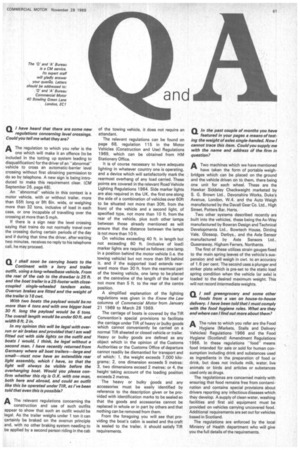Q / shall soon be carrying boats to the
Page 63

If you've noticed an error in this article please click here to report it so we can fix it.
Continent with a lorry and trailer outfit, using a long-wheelbase vehicle. From the rear of the cab to the drawbar is 25 ft. and the boat trailer is a 25-footer with closecoupled single-wheeled tandem axles. Overrun brakes are fitted and the weight of the trailer is 18 cwt.
With two boats the payload would be no more than 4 tons and with one bigger boat 30 ft long the payload would be 6 tons. The overall length would be under 60 ft. and width 8 ft. 2 in.
In my opinion this will be legal with overrun or air brakes and provided that I am well fitted out with side lights on the outfit and boats I would, think, be legal without a second man. I have recently returned from Germany where all boat trailers—large and small—must now have an extendible rear light assembly, which I have, so that the light will always be visible before the overhanging boat. Would you please confirm whether this rig is O.K. with one man, both here and abroad, and could an outfit like this be operated under TIR, as I've been told that even this is possible?
AThe relevant regulations concerning the
construction and use of such outfits appear to show that such an outfit would be legal. As the trailer weighs under 1 ton it can certainly be braked on the overrun principle and, with no other braking system needing to be applied by a second person riding in the cab of the towing vehicle, it does not require an attendant.
The relevant regulations can be found on page 68. regulation 115 in the Motor Vehicles (Construction and Use) Regulations 1969, which can be obtained from HM Stationery Office.
It is of course necessary to have adequate lighting in whatever country one is operating, and a device which will satisfactorily mark the rearmost overhang of any load carried. These points are covered in the relevant Road Vehicle Lighting Regulations 1964. Side marker lights are also required in the UK, the first one along the side of a combination of vehicles over 60ft to be situated not more than 30ft. from the front of the vehicle and a second light, of specified type, not more than 10 ft. from the rear of the vehicle, plus such other lamps between those already mentioned as will ensure that the distance between the lamps is not more than 10 ft.
On vehicles exceeding 40 ft. in length but not exceeding 60 ft. (inclusive of load) marker lights are required as follows: one lamp in a position behind the motor vehicle (i.e. the towing vehicle) but not more than 5ft behind it, and if the supported load extends rear ward more than 30 ft. from the rearmost part of the towing vehicle, one lamp to be placed at the centreline of the length of the load or not more than 5 ft. to the rear of the centre position.
A simplified explanation of the lighting regulations was given in the Know the Law columns of Commercial Motor from January 21 1969 to March 28 1969.
The carriage of boats is covered by the TIR Convention's special provisions to facilitate the carriage under TIR of heavy or bulky goods which cannot conveniently be carried on a normal TIR sheeted or closed vehicle or trailer.
Heavy or bulky goods are defined as any object which in the opinion of the Customs Authorities or the Customs Office of departure cannot readily be dismantled for transport and of which: 1. the weight exceeds 7.000 kilograms: 2, one dimension exceeds 5 metres: 3, two dimensions exceed 2 metres: or 4, the height taking account of the loading position exceeds 2 metres.
The heavy or bulky goods and any accessories must be easily identified by reference to the description given or be provided with identification marks to be sealed so that the goods and accessories cannot be replaced in whole or in part by others and that nothing can be removed from them.
From the foregoing you will see that providing the boat's cabin is sealed and the craft is sealed to the trailer, it should satisfy TIR requirements.
















































































































